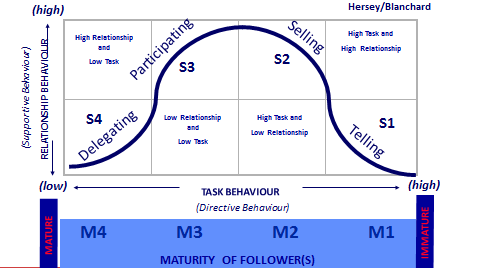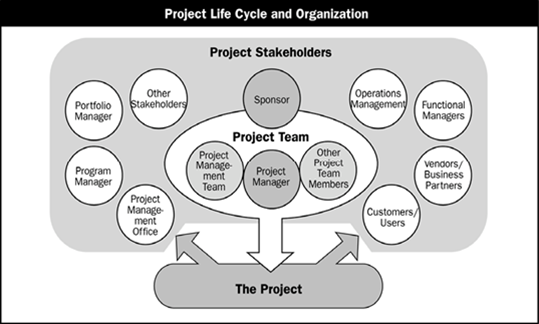The Situational Leadership theory, developed by Hersey and Blanchard from the 1970’s onwards, stated that leadership needed both task behavior as well as relationship behavior in order to get the best performance from people.
It also understood that people that are tasked with a job may have different levels of competence (ability, knowledge, skill) as well as different levels of commitment (confidence and motivation) with regards to a specific task.
Based on the above, they developed 4 leadership styles and identified as a leadership quality the ability of the leader to gauge the different levels and act accordingly. These styles are:
‘Telling’ style when
- Competence is low so requiring high task behavior (from the leader), and
- Commitment is high so requiring low relationship behavior.
‘Selling’ style when
- Competence is low so requiring high task behavior, and
- Commitment is low so requiring high relationship behavior.
‘Participating’ style when
- Competence is high so requiring low task behavior, and
- Commitment is low so requiring high relationship behavior.
‘Delegating’ style when
- Competence is high so requiring low task behavior, and
- Commitment is high so requiring low relationship behavior.
This understanding lead Hersey to conclude that: “a good leader develops the competence and commitment of their people so they’re self-motivated rather than dependent on others for direction and guidance.”
 In 1977 Hersey and Blanchard parted ways and developed this model further independently. Blanchard incorporated research finding by others into his theory to develop Situational Leadership II®. He notably related the theory of Bruce Tuckman on team development to the leadership styles.
In 1977 Hersey and Blanchard parted ways and developed this model further independently. Blanchard incorporated research finding by others into his theory to develop Situational Leadership II®. He notably related the theory of Bruce Tuckman on team development to the leadership styles.
These team development stages are:
- Forming, where a telling style may be appropriate;
- Storming, where a selling style may be appropriate;
- Norming, where a participating style may be appropriate;
- Performing, where a delegating style may be appropriate.
The link to project management
It is this link of the Situational Leadership II® theory with team development that caught our interest, as project management is greatly dependent on teamwork and therefore project success hinges on how the team performs.
Matters are further complicated because projects are temporary and mostly done in phases, with each phase typically having a different team composition, so they are likely to go through the team development stages several times. Add to this the typical high staff turnover on project teams and we realize we are talking of highly volatile, living organisms.
How many project managers realize this? How many assess the project team maturity for a specific task and adapt their leadership style?
Another point is that the project manager directly manages the project management team, but often has to rely on tertiary channels when managing the ‘executing’ team. This in itself is a blog topic, but in this blog we’ll stay with the project management team (part of the wider ‘project team’). The project management team members are only engaged in managing the work, not doing it – except in very small projects:
- Using PRINCE2 terminology, they are the people who produce the management products, not the specialist products.
- Using PMBOK terminology, the people who produce the process deliverables, not the product deliverables.
With this in mind, we could say that on most projects, especially the bigger ones, the project manager almost always and immediately resorts to a delegating style. I have seen very few project schedules that allow time for ‘team ramp-up’ or ‘team training’. We just do not take the time for this.
The challenge in PM environment
Fact is, even if team competence is high from the start – a big ‘if’ because the best resources are not always readily available – we still need to allow time for team development, and therefore the team leader/project manager needs to adjust his/her leadership style accordingly.
I would even venture to say that there may well be a (negative) correlation between the competence of the individual team members and the time it takes to get the team performing. Again, a topic for another blog.
Another factor is that project managers work with multi-disciplinary and multi-organization teams with team members reporting to their respective line managers or bosses. This severely limits their formal powers over the team members, reason the more for paying attention to their people skills, and team leadership is certainly a key factor in bringing projects in successfully.
A great example of this is the Benfield column repair project by Sasol in South Africa[1], which won the PMI® PoY® (Project of the Year) award in 1995. Many different contractors worked on this unscheduled shutdown project. It was established that the success of this project was largely due to people management and especially worker motivation, i.e. leadership.
Conclusion
In conclusion, we certainly think there is merit in project managers taking note of Situational Leadership and especially SL II®, amongst the many other things there are to know, in order to continuously improve their craft and deliver project results to the benefit of their clients and teams alike. After all a team that develops as its members grow in strength can only benefit the next project.


This comment is By Dr. Murugesan Ramalingam on LinkedIn:
Contingent leadership, a form of situational leadership, is very relevant to project management as each project is unique!
This comment was added By Benson Adede on LinkedIn:
Mourir i do agree that situational leadership is relevant to project management especially depending on what is involved and the leader’s background. Managing a project in a field where you are a stranger, in a new environment and specific deadlines, in your field of study but various disciplines put together may require a lot of skill on both task and relationship leadership to be able to deliver. As a project manager, you will find yourself in different environment with any new project requiring that you personally change with the situation that you are in.
Asking questions are truly good thing if you are not understanding something entirely, however
this paragraph presents pleasant understanding even.